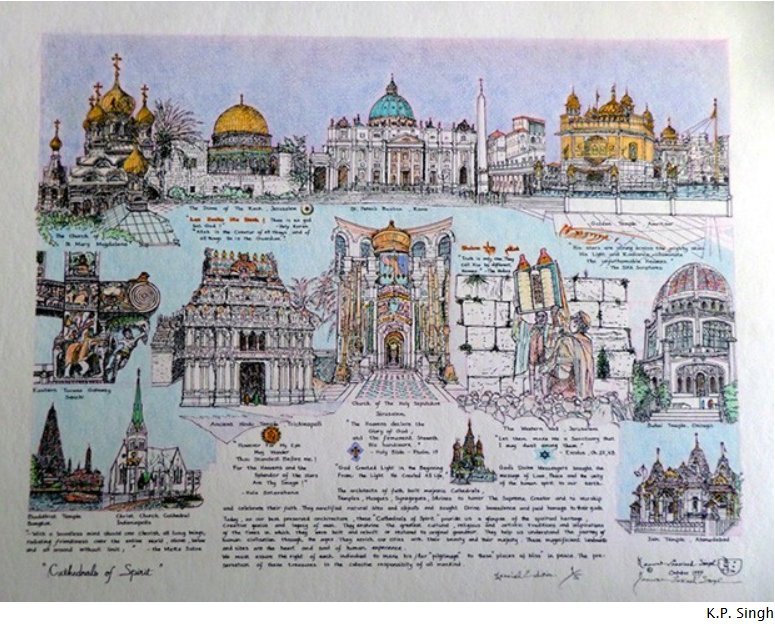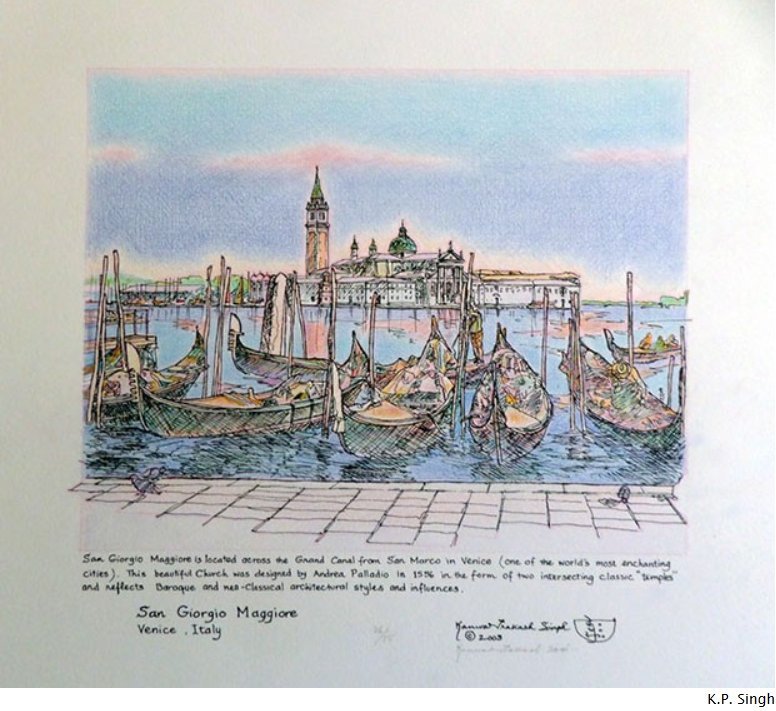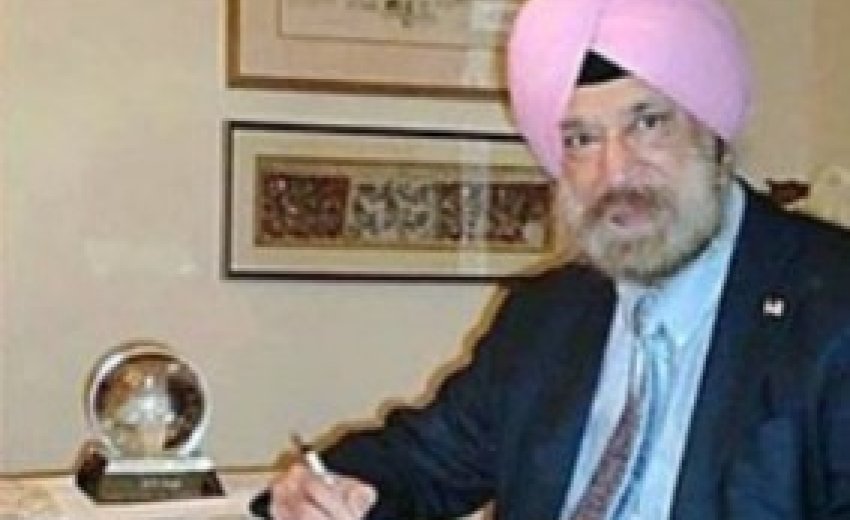Lines of Distinction
Internationally known illustrator K.P. Singh speaks with an elegance and cadence that turn his words into a dance. His designations include artist, advocate, author and public speaker and could easily welcome storyteller. Listening to him talk about his 50-year journey from his native India to the United States feels like stepping into a Jhumpa Lahiri novel.
As finely as he composes his pen-and-ink drawings of historic architecture and monuments, so does he detail a life bolstered by art and his Sikh faith.

The title of Singh's examination of places of worship Cathedrals of Spirit.
In 1965 Singh arrived in Ann Arbor where he pursued a degree in city planning at the University of Michigan. He had already attained degrees from Punjab University and The Indian Institute of Technology, and he came to the States in to spend time abroad before settling down. Though he returned to India for a formal ceremony celebrating his first marriage, he made Indiana his home in 1967.
Following the completion of his degree, Singh moved to Indianapolis and joined the Department of Metropolitan Development as a senior designer and urban planner. Here he held that position from 1967 to 1972, at which point he created his own fine arts enterprise, K.P. Singh Designs.
Though his training was not in art, drawing had been a component of his studies in planning and architecture in India and Michigan. His work in Indy revealed an ugly truth: A number of historic buildings were being demolished to make room for more parking lots.
"Having been surrounded by so much beauty and historic things in India, I wanted to convey as a planner and an artist that we as a civilization could not afford to destroy these landmarks," he says. "They had artistic architectural value." He explained that the buildings' facades, skylights, stained glass and designs had been inspired by other countries and cultures.
![]()
K.P. Singh has lovingly rendered some of the most iconic structures in his adopted home.
"If I showed in drawings how beautiful these buildings were, it would draw attention. An image is worth a thousand words," he says.
Singh's plan paid off. He created one pen-and-ink drawing and soon had requests for images of buildings such as the Monument Circle, the State House and the Athenaeum. To date, he has captured hundreds of historic structures on paper, detailing everything from the history of college campuses to places of worship. Forty framed selections of his artwork will be on display in the Ruth Lilly Library at the Indianapolis Art Center (820 E. 67th St.) beginning this Friday, Sept. 25.
The exhibit, "K.P. Singh in Color: Selected Prints and Drawings," is part of the IAC's fall exhibition that explores contemporary realism. Kyle Herrington, director of exhibitions at the IAC, says he immediately thought to include Singh in the show. Not only is Singh a longtime supporter of the IAC, having recently attended his 45th consecutive Broad Ripple Arts Fair, but his work "showcases traditional work in a unique way."
Herrington says, "I wanted a complementary artist and Singh's drawings and prints of landmarks and architecture celebrate the city."
The exhibition kicks off with a reception on Sept. 25th from 6 p.m. to 9 p.m. and will be on display through Nov. 21.
Singh has been involved in his art and the support of art since his arrival in the Circle City. His deep love and respect for Indianapolis are immediately apparent. He describes walking past Monument Circle when he first arrived in the city:
 |
| In 1967 K.P. Singh made Indianapolis his home.
|
"I saw people on the Circle having lunch ... I saw the spirit of the people who were on the monument steps and felt this was a city that had a lot of promise. I wanted to be part of the journey, I wanted to add to it, to witness it. The city had lots of offerings without the complications of larger cities. I love being part of the community and witnessing its gradual transition and tremendous transition in other areas. It has been a joy to be part of that. I don't know any other home."
As a former city planner, an artist and a traveler, Singh is proud that Indianapolis has changed from the often mocked "Indiananoplace" to a recommended travel destination in a 2014 New York Times article.
He credits former mayor Richard Lugar for appealing to his constituents to welcome newcomers and to encourage them to share their gifts in order to enrich their own lives and their community. That positive approach found Singh wholeheartedly welcomed upon his arrival. In turn, he made himself accessible:
"It's an important attitude for new immigrants to think about," he says. "In America we love being part of community, part of an experience, opportunity and responsibility. Instead of saying 'No, that's not my cup of tea,' I said, 'Cool, you want to include me; I would be very happy to [participate].' We don't need to shy away from unfamiliar things. We need to be willing to learn and willing to take a chance. It's part of my responsibility to know about you and your journey and someday if you're interested, you can hear about my journey."
Wanting to be part of new possibilities, rather than clinging to his own traditions and culture, helped Singh grow and learn. It helped open doors at prestigious tables and presented possibilities he couldn't have possibly imagined. Every morning, he says, he thanks the Lord for those blessings that helped his spirit. "Make a place at the table for others," he says. "Create a space so others feel comfortable enough to come in and share their gifts."
Singh's sense of calm and appreciation for the life he has been able to live is directly related to his days as a youth in India. He was born in the part of India that is now Pakistan.
| Any study of Indiana's iconic buildings must include the Soldiers and Sailors Monument. |
"We became refugees," Singh says, "forced to leave our home because of violence. It was not a happy move." Nearly 3 million people lost their lives in what Singh describes as a "tremendous case of ethnic cleansing." He remembers that on Sept. 8, 1947, in his hometown 20,000 people were massacred. He recalls this detail not because of its morbid nature, but because he was spared. As a result, he says, "Every day is an anniversary, every day is blessed, every hour I've had is like a rebirth."
Singh continues, "Maybe God has a reason why I'm still here. So many people didn't make it. The higher power is at work directing lives, transforming lives, creating thresholds and transitions. I look forward to interfacing with new ideas and thoughts, new people to meet, crossroads, things I didn't know about the day before."
Art has two messages for Singh: First, to his fellow Hoosiers, he says, "These are your treasures." Second, art has an important role in the sharing of those treasures. His drawings do not just capture a brick-and-mortar structure, he explains. The landmarks represent the very essence of human journey, lifestyle, innovation and sacrifice.
"This is your heritage, part of your spirit," he says, inviting people to explore more deeply. "It's not just about the Purdue Fountain," which he drew in 1998. "There's a lot more behind it. What other things does it enshrine?"
The words that Singh includes with his illustrations add to the composition and understanding of the drawing, broadening appreciation for what the viewer is seeing and enjoying.
"I began to challenge people to read the text and see it from their perspective. 'This is what I feel,' 'You may feel differently,"' he says.
Including words with his drawings has been important to his career as a writer, adding another dimension to his love and prayer for his art and all that surrounds us.
 |
| This drawing shows San Giorgio Maggione in Venice, which Singh describes as "one of the world's most enchanting cities."
|
"I designated myself as an advocate for the arts," Singh says. "Art has much to add to the spirit of a community, to the richness of the family, the richness in schools, the richness of the human spirit itself. Civilization, family, the city ... they're a work in progress," he continues. "I hope [the city] never arrives in a place where we say 'This is now finished.' You can do that with a drawing, but humanity is a work in progress. Every citizen counts, every citizen can contribute."
Singh continues, "Art is unifying and transcendent. If we love a community, we have to give ourselves beyond our own personal and professional needs to contribute to its richness, as friends of the community and as friends of city. Only art can enrich our spirit."
Visit K.P. Singh's website for a look at his many fine art drawings, or visit his Facebook page for both artwork and essays.
<><><><><>

